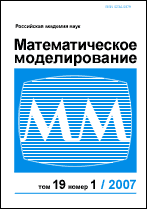|
This article is cited in 1 scientific paper (total in 1 paper)
Statistical characteristics of the anomalously large surface waves based on computational experiments
R. V. Shamin, A. V. Yudin
Peoples’ Friendship University of Russia
Abstract:
In our computational experiments we simulate the two dimensional potential flow of ideal liquid with a free surface. We used results of these experiments for investigating statistics of occurrence of abnormally large surface waves in depending on initial parameters. The suddenness of the occurrence of abnormally large waves in the ocean defines serious danger that they pose to ships and marine buildings. Now we have incontrovertible evidence of this phenomenon such as the instrumental recordings and photographs. The main method of studying the phenomenon of rogue waves in our work is computational experiment that is based on the full nonlinear equations of hydrodynamics of ideal liquid with free surface. We apply the method of conformal variables to the original system of equations. This method allows doing efficient and accurate calculations using computers. According to the results of experiments investigated the statistics of occurrence of abnormally large surface waves. Using dissipation and pumping in these computational experiments will spend long calculations, which did not cease in case of rogue waves. Estimates were made of the intensity of the occurrence of the rogue waves, depending on the values of the squares of the average steepness and wave dispersion. It is shown that in doubling the calculated field intensity is nearly doubled. The proposed methods of computational experiments allows estimating the average waiting time of rogue waves in a given area.
Keywords:
surface wave, rogue waves, abnormally large waves in the ocean, computer experiment.
Received: 01.09.2015
Citation:
R. V. Shamin, A. V. Yudin, “Statistical characteristics of the anomalously large surface waves based on computational experiments”, Mat. Model., 28:9 (2016), 31–42; Math. Models Comput. Simul., 9:2 (2017), 176–184
Linking options:
https://www.mathnet.ru/eng/mm3765 https://www.mathnet.ru/eng/mm/v28/i9/p31
|

| Statistics & downloads: |
| Abstract page: | 408 | | Full-text PDF : | 116 | | References: | 57 | | First page: | 13 |
|




 Contact us:
Contact us: Terms of Use
Terms of Use
 Registration to the website
Registration to the website Logotypes
Logotypes








 Citation in format
Citation in format 
